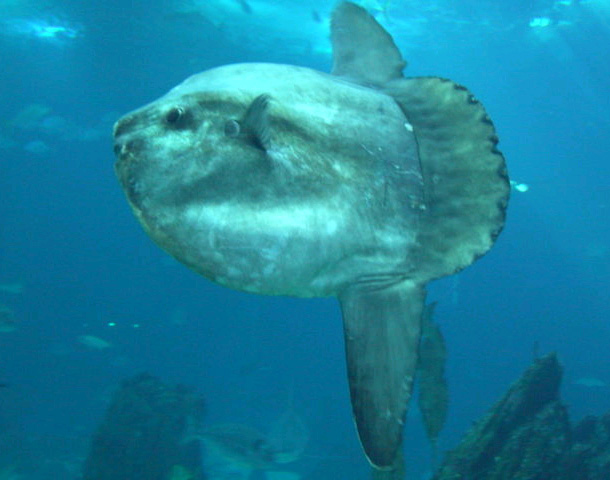คำตอบที่ 85
Ocean sunfish
From Wikipedia, the free encyclopedia
Jump to: navigation, search
This article is about the ocean sunfish, Mola mola. For other fishes known as "sunfish", see sunfish.
Ocean sunfish
Scientific classification
Kingdom: Animalia
Phylum: Chordata
Class: Actinopterygii
Order: Tetraodontiformes
Family: Molidae
Genus: Mola
Species: M. mola
Binomial name
Mola mola
(Linnaeus, 1758)
The ocean sunfish (Mola mola) or common mola is the heaviest bony fish in the world, with an average weight of 1000 kilograms. The species is native to tropical and temperate waters around the globe. It resembles a fish head without a tail, and its main body is flattened laterally. Sunfish can be as tall as they are long, when their dorsal and anal fins are extended.
Sunfish live on a diet that consists mainly of jellyfish. As this diet is nutritionally poor, they consume large amounts in order to develop and maintain their great bulk. Females of the species can produce more eggs than any other known vertebrate. Sunfish fry resemble miniature pufferfish, with large pectoral fins, a tail fin and body spines uncharacteristic of adult sunfish.
Adult sunfish are vulnerable to few natural predators, but sea lions and orcas will consume them. Among humans, sunfish are considered a delicacy in some parts of the world, including Japan and Taiwan, but sale of their flesh is banned in the European Union. Sunfish are frequently, though accidentally, caught in gillnets, and are also vulnerable to harm or death from encounters with floating trash, such as plastic bags.
A member of the order Tetraodontiformes which includes pufferfish, porcupinefish and filefish, the sunfish shares many traits common to members of this order. Sunfish was originally classified as Tetraodon mola. under the pufferfish genus. But it has since been given its own genus, Mola, with two species under it. The ocean sunfish, Mola mola is the type species of the genus.
Contents [hide]
1 Naming and taxonomy
2 Description
2.1 Fins
2.2 Skin
3 Range and behavior
3.1 Feeding
3.2 Life cycle
4 Human interaction
4.1 Sunfish in captivity
5 Notes and references
6 External links
6.1 Research and info
6.2 Images and videos
[edit] Naming and taxonomy
Many of the sunfish's various names allude to its unique flattened shape. Its specific name, mola, is Latin for "millstone", which the fish resembles because of its grey color, rough texture, and rounded body. Its common English name, sunfish, refers to the animal's habit of "sunbathing" at the surface of the water. The French- and Spanish-language names, poisson lune and pez luna, both mean "moon fish", in reference to its rounded shape. In German, the fish is known as Schwimmender kopf, or "swimming head", because it has no true tail. Some Taiwanese refer to it as the "toppled car fish" for its tendency to lie on its side while sunbathing. In Taiwan's Hualien County, where sunfish are featured as the official mascot, they are known as the "mambo fish" for their swimming motions.
The ocean sunfish has various obsolete binomial synonyms, and was originally classified in a pufferfish genus, as Tetraodon mola.[1] [2] It is now placed under its own genus, Mola, with two species under it: Mola mola and Mola ramsayi. The ocean sunfish, Mola mola is the type species of the genus.[3]
The Mola genus belongs to the Molidae family. This family comprise 3 genera: Masturus, Mola and Ranzania. The common name "sunfish" without qualifier is used to describe the Molidae marine family as well as the freshwater sunfishes in the family Centrarchidae which are unrelated to Molidae. On the other hand, the name "ocean sunfish" and "mola" refer only to the family Molidae.[4]
The Molidae family belongs to the order Tetraodontiformes which includes pufferfish, porcupinefish and filefish. Sunfish shares many traits common to member of this order, including the four fused teeth that form the characteristic beak and gives the order its name (tetra=four, odous=tooth and forma=shape). Indeed, sunfish larvae resemble spiky pufferfish more than they resemble adult molas.[5]







